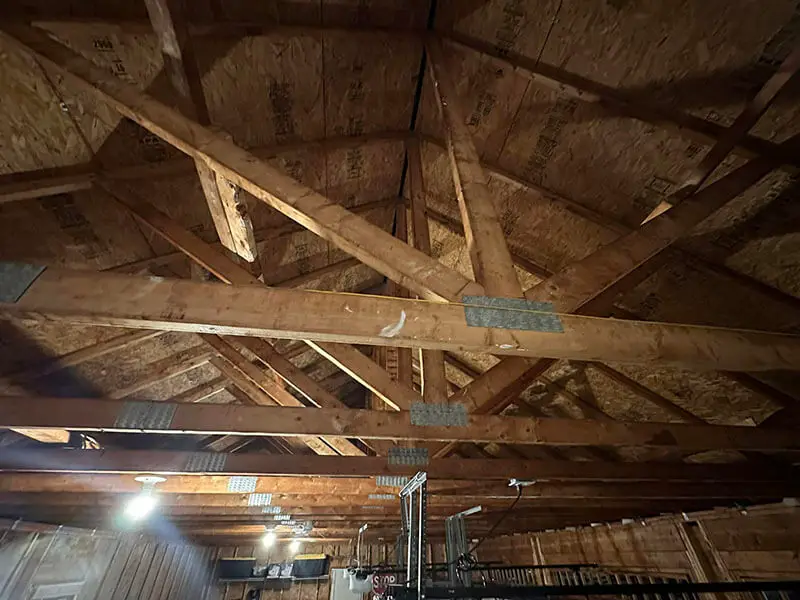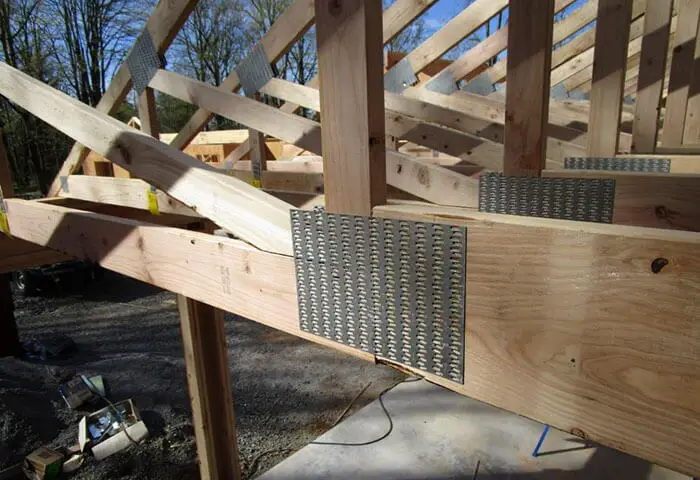A 2×4 Truss Span Without Support can go a maximum of 35 feet, which is optimal and used by many of us, but you can go 40 feet if the weight is lower, and the spacing would be higher too. You might have heard or seen somewhere that the max span can be 70 feet, but I strongly suggest against that as it is very impractical.
Besides, you must consider wood type, psi, spacing, roof and material weight, sloop, and other factors to calculate the maximum of a 2×4 truss span. I will discuss all these in detail in the following sections.
Quick Jump
Factors That Affect Maximum Span of 2×4 Truss

As you can see, there is no exact measurement in this case because a few factors affect how far your 2×4 truss span goes. You must consider these factors before building for the safety and stability of the structure and you and your family.
I will try to give you as much information as you need to provide you with an understanding. There are three primary factors to know how far a 2×4 truss can span without support.
Factor #1: Wood Type
You might have guessed and already know that wood type is crucial. As you know, various kinds of wood can be used for a 2×4 truss span, all with unique characteristics. But, here, I’ll discuss a few popular options, regardless of where you’re building, the environment, and other factors considered.
| Type | Characteristics |
| Douglas Fir | # A high strength-to-weight ratio and stiffness # Resistant to moisture # Expensive |
| Spruce-Pine-Fir (SPF) | # The combination of spruce, pine, and fir # Lightweight # Low cost # Not suitable for larger spans |
| Southern Yellow Pine | # Strong and dense # Relatively affordable # Widely available # Prone to warping and splitting |
| Hem-Fir | # A combination of hemlock and fir # High strength-to-weight ratio # Resistance to decay # Expensive |
Here are some rules of thumb to give you a better understanding and comparison;
- A stiffer wood like Douglas Fir may be the best choice if the truss requires a lot of flexing.
- On the other hand, sometimes moisture is a concern when you live in a place with a lot of rain or winter. In that case, a wood like Douglas Fir or Hem-Fir may be the best choice.
- Price is a big concern, and I get it. I would suggest considering a wood-like SPF.
- Lastly, lightweight woods like SPF or Hem-Fir might be a good choice if weight is a concern.
As I said, the bottom line is the best type of wood for a 2×4 truss span will depend on the project’s specific needs and not to mention your local area’s building codes and regulations.
Sometimes, we don’t know everything, and it might be time-consuming. And, It’s always best to consult an expert before choosing a type of wood.
Factor #2: Spacing
Spacing can be tricky as it depends on the roof size and weight requirement. Besides, local building codes and regulations sometimes get in the way.
Two things you need to remember;
- Closer spacing means more trusses, supporting greater weight and span a longer distance.
- On the other hand, if you want the trusses to be a bit far apart, that can’t support much weight as it does with closer spacing.
But, the cons of closer spacing are that it will require more materials and labor, which can increase the project’s cost.
I would strongly suggest using closer spacing for the long term, as the house will be there, and it can support more weight and is more stable that way.
Factor #3: Weight Capacity
The third factor while dealing with truss span is how much weight the trusses need to carry, including the size and all the components that will be connected.
Besides, when determining the maximum span of a 2×4 truss, you must also consider the weight of the roof, ceiling, and any additional load, such as insulation, ventilation, and electrical parts.
Here’s the most crucial part of why weight is essential because, as you might know, the weight is calculated as pounds per square foot for the roof surface area. When the total weight per square foot increases, the maximum span of the truss span will automatically decrease because of the weight.
That’s not all! There are a few other factors that you need to keep in mind besides wood type, spacing, and weight capacity.
Another factor to consider is the slope or pitch of the roof. It will affect three things, the weight, wind, and snow loads. Choosing a steeper slope will increase the load on each truss as the roof’s weight is distributed over a smaller surface area.
Remember the wind and snow loads, too, as they can affect trusses’ load-bearing capacity. You must also ensure compliance with local building codes and regulations and the structure’s safety and stability.
These are more or less the factors that will affect the maximum 2×4 truss span.
How to Calculate the 2×4 Truss Maximum Span

As multiple factors will affect the truss span limit without support, you must consider them. I will go through and shuffle up the combination to give you a better understanding of how to calculate with suitable examples.
Let’s get started!
One important thing to clear up is you must use the load-span tables provided by the American Wood Council as a reference.
As you might remember, we need three things, such as wood type, spacing, and weight, to calculate a 2×4 truss span without support.
But, besides, you will need more information. But before that, let’s see the formula.
The formula for calculating Maximum Span = (Strength of Wood x Spacing of Trusses x Width of Truss) / (Total Weight on Truss)
As you can see, you will need a few things to start processing. I will go through a step-by-step process, beginning with the strength level of different types of wood.
Step #1: Find the Strength of your Wood Type
For example, here is a list of typical strength values for different types of wood that can be used for a 2×4 truss.
- Spruce Pine Fir: 750 psi
- Douglas Fir: 1,200 psi
- Southern Pine: 1,000 psi
- Hem-Fir: 750 psi
- Redwood: 900 psi
- Cedar: 580 psi
Step #2: Find the Optimal Spacing
Now you need to know the spacing of the trusses. There are no exact numbers, but here is some recommended spacing for different types of wood.
- Spruce Pine Fir: 24 inches on center.
- Douglas Fir-Larch: 24 inches on center.
- Southern Pine: 24 inches on center.
- Hem-Fir: 24 inches on center.
- Redwood: 16 inches on center.
- Cedar: 16 inches on center.
Step #3: Figure out the Weight
Now, that’s the tricky part. You need to know these to find the overall weight. I will give you an example.
I have;
- A shed with a gable roof that measures 12 feet wide by 16 feet long.
- The width of the Truss is 3.5 inches.
- The roof’s pitch is 4/12 (12 inches of horizontal run, the roof rises 4 inches).
- Asphalt shingles approximately weight 2.5 pounds per square foot.
First, calculate the total area of the roof, with a width of 12 feet and a length of 16 feet.
So, the total area = 192 square feet.
But you need to convert it to square inches, which is 192 square feet x 144 square inches per square foot = 27,648 square inches.
So, the weight will be = (27,648 x 2.5) / 144 = 480 pounds or 217.724 kgs.
Step #4: Calculate the Maximum Span of a 2×4 Truss
After everything, we can now calculate how far can a 2×4 truss span without support.
So, Maximum Span = (Strength of Wood x Spacing of Trusses x Width of Truss) / (Total Weight on Truss)
Maximum Span = (750 psi x 24 inches x 3.5 inches) / (480 pounds) = 131.25 inches or 332.74 cm or 10.9167 feet
It was just an example. As you can see, there are psi, optimal spacing, width, and optimal weight, and you can take the lowest amounts and find your maximum truss span.
I will give more examples with a few wood types, different spacings, widths, and weights.
Example #1:
Wood type: Douglas Fir (1,200 psi)
Spacing: 24 inches
Width: 3.5 inches
Weight: 300 pounds
Maximum Span = (1200 psi x 24 inches x 3.5 inches) / (300 pounds) = 336 inches or 853.44 cm or 28 feet
Example #2:
Wood type: Southern Pine (1,000 psi)
Spacing: 24 inches
Width: 3.5 inches
Weight: 300 pounds
Maximum Span = (1000 psi x 24 inches x 3.5 inches) / (300 pounds) = 280 inches or 711.2 cm or 23.33 feet
Example #3:
Wood type: Douglas Fir: 1,200 psi
Spacing: 24 inches
Width: 4 inches
Weight: 270 pounds
Maximum Span = (1200 psi x 24 inches x 4 inches) / (270 pounds) = 426.66 inches or 1083.71 cm or 35.55 feet
As you can see, I have taken multiple variables to determine the max 2×4 truss span. As a result, the lower the weight, the higher the max span. At the same time, the higher the psi, spacing, and width will be, the higher the number will be.
Besides, you already witnessed that when I took the Douglas fir and the max spacing for that wood, the max span stood at 35 feet. If you can lower the weight, the max span can reach 40 feet without support.
Safety Tips For Building With 2×4 Trusses

I have seen too many accidents while building roofs or any construction or home-building work, so I had to share these safety code tips. Here they are;
- Before building any structure, you must check with your local building department to ensure compliance with local building codes and regulations. If that’s a hassle, you can always talk to an expert, and they will take care of it.
- Using cheap or lousy wood never brings good outcomes, so choose the right type of wood that can safely support the weight of the structure and any additional loads.
- Sometimes you might like to use pre-fabricated trusses. In that case, you must follow the manufacturer’s guidelines for installation and bracing.
- Working on such things in sunny weather is always better, as water might make everything slippery.
- One friend was severely injured because he didn’t use proper safety equipment like harnesses, safety ropes, and safety nets. But we both know how important that is.
Besides, it’s always ok to ask for help from friends and experts for suggestions in the work process.
Wrap Up
That’s everything I got on this topic. I hope it helped you to know the things, or with the intention, you came here as I answered your question that a 2×4 truss span could go as far as 70 feet, but staying within 35 to 40 feet would be a good choice.
Besides, ensure to maintain all these factors and safety tips. Good luck!

Roger Lewis is an experienced roof repair contractor with over 15 years of industry experience. He is known for his expertise in all aspects of roof repair, including leak detection, shingle replacement, and gutter repair.
